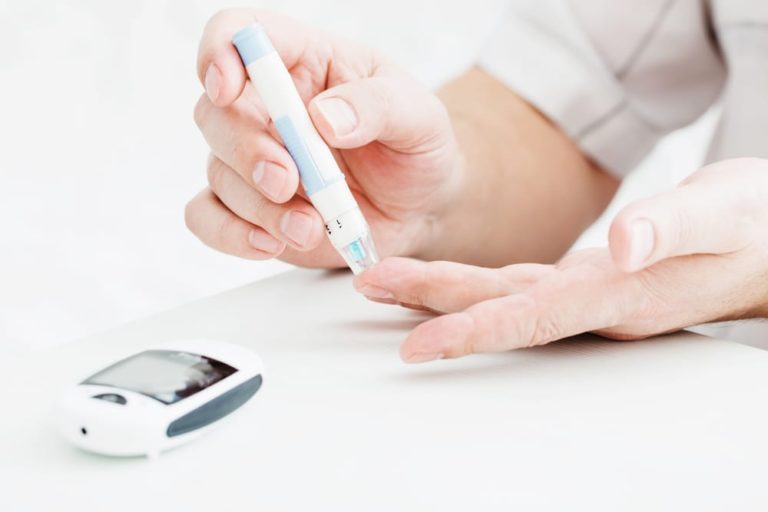Everyone is talking about it at the moment: Intermittent fasting, part-time fasting or intermittent fasting (IF for short).
So now you’re supposed to skip breakfast, go days without eating, or just skip a meal in between? How is that supposed to work. In the past, the motto was “don’t skip a meal”.
What was wrong in the past is right today? Is intermittent fasting just another new trend? We clarify.
Preliminary: It is often called intermediate fasting. This is simply wrong.
1. why it sometimes makes sense to eat nothing
The warning not to skip breakfast applies to all carbohydrate junkies. Because if your body has been used to getting fresh carbs every few hours, it can’t handle it.
If you’re a carbohydrate burner and you forgo breakfast, your body goes on alert. “Help, no carbs, what do we do now. Let’s get irritable, unfocused, and best of all, curb the energy burn”. Your body gets directly afraid that it will not make it until the evening, if it continues to look so tight with the energy supply. He starts cutting corners.
Unlike a body that has already learned to get energy from fat, the carbohydrate junkie’s body is not very good at this skill. Therefore, in the panic, it tries to get energy from muscles and breaks down proteins.
The conversion to energy production from fat takes a while. What exactly happens in the body during this time is described in the article“What happens in the metabolism without carbohydrates?
So skipping breakfast once isn’t enough to get you into fat-burning mode.
Undoubtedly, however, it makes a lot of sense for any carbohydrate junkie to give up the constant snacks between meals. 3 meals a day are quite enough. That way, you won’t let your blood sugar go on a roller coaster. Due to the many small snacks, which mostly consist of simple carbohydrates, there is a very fast and strong increase in your blood sugar level. Since these simple carbohydrates are absorbed into the cells fairly quickly by the hormone insulin, your blood sugar level also drops quickly and may even drop to a lower level than before the snack. As a result, there may be a lack of concentration or even fatigue. If your body is exposed to this condition more often, you may also experience other problems, such as high blood pressure. Therefore, even if you are a carbohydrate junkie, you should be careful to avoid such blood sugar spikes.
Our tip for carbohydrate burners: 3 meals a day. No more, no less.
From carbohydrate junkie to fat burning machine
The situation is completely different if your body has already learned to obtain energy from fat. If so, intermittent fasting is a welcome new tool to challenge your metabolism.
To teach the body this ability and retrain it from a carbohydrate junkie to a fat burning machine takes two things: the right diet and time.
The training begins with the abandonment of the classic sources of carbohydrates (pasta, pasta, rice). Ideally, you reduce the amount of carbohydrates you eat per day to 30 or 50 g per day. You eat 3 meals a day made up of lots of vegetables, high quality protein and a good portion of fat.
This form of nutrition is called a ketogenic diet. This is a type of low carb diet that focuses on the creation of so-called ketone bodies. The main source of energy for your body here is not carbohydrates, but fats. The fat burning is thus properly boosted and you become a real fat burning machine.
You can find the instructions for this diet in our article “All about ketogenic diet“. You can also read about our book or directly book a suitable nutrition plan for you.
Once you’ve gotten your body used to the new diet for 30 days, you’re ready for intermittent fasting!
Our tip for fat burners: test the different forms of IF for yourself – but only after 30 days of switching to a ketogenic or low carb diet.
For many people who have been eating ketogenic or low carb for a long time, intermittent fasting comes naturally. They automatically forget to eat for hours and are not hungry between meals. Behind this is the inhibition of the “hunger hormone” ghrelin. The release of this hormone is curbed by a ketogenic diet, which helps you stay full longer and prevent cravings.
2. what is intermittent fasting?
Intermittent means “interrupted” – you do not fast completely for several days or weeks at a time, but the fasting phase is repeatedly interrupted by “eating phases”. This type of fasting, unlike other forms, can thus be used as a long-term diet6. Depending on the rhythm in which one alternates between eating and fasting, one distinguishes between different forms of intermittent fasting.
Du möchtest dich auch gesünder ernähren?
3. forms of intermittent fasting
Various forms of IF have now become widespread, which we will introduce to you in a moment. Some make more sense, some less. We recommend a 16:8 rhythm to get you started.
You may have encountered this rhythm in connection with the famous butter coffee (Bulletproof Coffee).
The fasting phase is 16 hours, and the eating phase is 8 hours.
In 16:8 interval fasting, people often replace breakfast with a coffee with butter and MCT oil. This does not interrupt the fat burning phase and still brings a very good energy boost. You can read about the meaning of butter coffee in our article onBulletproof Coffee.
After dinner, there is then a 16-hour break until the next solid meal. This is usually the lunch.
Example plan for intermittent fasting according to the 16:8 scheme:
9 am: Butter coffee with MCT oil and pasture butter (without protein powder!)
1 pm: Lunch
8 pm: Dinner
We’re assuming here that you’ll have eaten the last bite of dinner by about 9pm. Then the fasting phase starts after the meal at 9 pm and runs until the next day at 1 pm.
It is important that you consume zero carbohydrates, protein and solid food during the fasting phase.
If you’d like to incorporate interval fasting into your Foodpunk nutrition plan, customer support will be happy to help.
While we recommend the 16:8 method to anyone testing IF for the first time, it is far from the only method.
Good To Know: Is it okay to eat fat during fasting?
Protein interrupts the fasting phase as it leads to insulin release. Insulin is virtually the antagonist of all fasting processes.
Carbohydrates also interrupt fasting processes, to a much greater extent than protein. They lead to an even stronger insulin release and are therefore taboo during the fasting phase.
…if you don’t overdo it. Consumption of pure fat (for example, in butter coffee) does not interrupt fasting metabolism because it does not cause insulin release. If you do not stir fat into the coffee in excessive quantities. Because then even fat can increase insulin levels.
This is a toned down version of 16:8 where the fasting phase is only 14 hours and the eating phase is 10 hours. Suitable for those who can not lift the long fasting window because hunger becomes too much. This scheme is also suitable for those who prefer to consume 3 meals during the eating phase.
Example plan for intermittent fasting according to the 14:10 scheme:
7 o’clock: butter coffee with MCT oil and pasture butter
10 am: Breakfast
2 pm: Lunch
7 pm: Dinner (until 8 pm)
With this form, you skip meals when it suits you. A meeting during the lunch break? All clear! The alarm clock did not ring? No issue, just skip breakfast. So the 16:8 fast is also a form of meal skipping. Meal skipping comes naturally to keto-adapted people (keto-adapted means that the body is already accustomed to a very low-carb, ketogenic diet). Many people enjoy this freedom. Within the very low carbohydrate ketogenic diet, hunger is not as pressing. While being a carbohydrate burner makes you unfocused, irritable and less able to perform when you forgo meals, things are different for the keto-adapted fat burner. You do get a little hungry, but there’s nothing wrong with waiting a few more hours. Neither the mood nor the concentration are affected, because the fat burner always has the energy with it.
With this form, there is only a 4-hour eating window each day. Most devotees use dinner and go without for the day. We recommend this form only to very experienced people who have already been eating ketogenic or low carb for a very long time and who can easily follow through with the 16:8 fast.
Example plan for intermittent fasting according to the 20:4 scheme:
During the day: Fasting
4 pm: Small snack
7 p.m.: Big dinner (until 8 p.m.)
The 20:4 fast is also called the “WarriorDiet” and refers to our ancestors who hunted or gathered food during the day and ate only in the evening.
“One Meal a Day.” With this diet, the goal is to get the nutrients you need within one meal. This form is very similar to the 20:4 fast. But often the eating phase is only 1 hour long.
The 36:12 fast involves fasting for a complete day. This involves fasting for 36 hours at a time, for example from 8 p.m. to 8 a.m. the day after next, followed by a 12-hour eating period. In the example, that would be from 8 a.m. to 8 p.m. In fact, we do not recommend this form. The advantages of the longer fasting period no longer outweigh the disadvantages of going without food for too long. These can include headaches, fainting, weakness, or cravings.14 For the body, prolonged fasting is also always a stressful situation that is detrimental in the long run.
Or Alternate Day Fasting. Here we eat every other day. This means 3-4 days per week of complete abstinence from food. We do not recommend this form either, as similar adverse effects can occur here as with 36:12 fasting.
For once, this designation does not speak of hours, but of days. So within a week you fast on 2 days and eat normal amounts on 5 days. On fasting days it is recommended to eat 500-600 kcal. There are recommendations for the foods that may be eaten on fasting days, however, one can also find descriptions of this form of fasting that do not allow or prohibit any specific foods. From our point of view, this form only makes sense if the fasting days are emphatically high in fat and contain little protein. If, on the other hand, you eat more protein and carbohydrates, you can’t really talk about fasting anymore – instead, it’s simply a drastically calorie-reduced diet. No recommendation from us.
With this rhythm you have one or two fasting days a week. These do not directly follow each other, but can be freely distributed over the week. Since we do not recommend complete fasting days, this form also does not get a recommendation from us.
4. what you should eat during the eating phase
Now we come to the question of all questions: What am I allowed to eat at all during the eating phase?
Of course, you shouldn’t just stuff everything and as much as you can into yourself. That’s not the point behind intermittent fasting. To keep your fat burning, you should continue to eat a low carb/keto diet. Since you have already prepared your body before the beginning of the “fasting time” with this form of nutrition, this should not be difficult for you. Also, the amount of food you eat should not be different from what it was before you changed your diet. The portions remain the same! So what does this mean for your meals: Less carbs, focus on quality protein and fat sources, don’t overeat! Thus, your blood sugar level remains low and the breakdown of fat as an energy source for your body is further promoted. Which foods are suitable for a ketogenic diet and which are not you can read in our article about ketogenic nutrition. And how you create delicious low carb/keto dishes from these foods, we’ll tell you in a moment, don’t worry.
5. why is intermittent fasting good for you?
Intermittent fasting stimulates autophagy
Fasting has a very special ability. It stimulates autophagy. And it’s like spring cleaning for your cells.
We have already talked about autophagy in detail in the article on butter coffee, but we want to revisit a few points here.
Fasting puts the body under stress. In a pleasant dose, stress is positive (even sport, for example, means stress, but in normal quantities it is good for the body). Due to the stress, the cell begins to digest itself. It sounds scary, but it’s a completely natural process. Old, no longer needed or broken cell components are broken down. The cell thereby gains new energy. After the fasting phase, it can rebuild new, fresh cell components. Why is this so important? On the one hand, autophagy is important to maintain the balance between the degradation of old cellular components and the production of new ones. In addition, it allows defective and damaged components to be broken down and thus not cause further damage to our body. Pathogens can also be broken down in this way. And it gets even better! This is because autophagy plays an important role in the prevention of diseases such as cancer, diabetes and autoimmune diseases.7
And you can do all of this through intermittent fasting alone! Pretty cool, right?
Intermittent fasting trains fat burning
An already well-trained fat burning system is important before you start intermittent fasting. Still, fasting in itself can kick it up a notch and is an extra workout for your fat metabolism.
In studies, short-term fasting has been associated with increased resting energy expenditure. This occurs through special messenger substances that are released during fasting. The trigger for the release of these messenger substances is probably the lower glucose concentration in our blood that we achieve by fasting. Just by changing your diet and the resulting change in your metabolism, you consume more energy – without any exercise.
Intermittent fasting makes you alert and focused
Autophagy is important for our nerve cells. They, too, must function properly. If malfunctions occur, we can suffer from various diseases. Proper functioning of our nerve fibers and synapses (the switching points between our nerves) is important for perfect motor skills as well as for our ability to think and concentrate.
Autophagy, just like ketogenic diet, promotes the formation of ketone bodies such as ß-hydroxybutyrate. And these ketone bodies are the perfect energy suppliers for our brain.
Intermittent fasting can regulate blood sugar levels
Studies show that intermittent fasting in animals leads to lowered glucose and insulin levels in the blood. This effect can also be seen in humans. If you constantly consume carbohydrates throughout the day, your blood sugar level goes on a roller coaster. Intermittent fasting can stabilize it. You also achieve increased sensitivity to glucose and insulin, reducing the risk of developing type II diabetes.9 10
Intermittent fasting can improve cardiovascular health
It has been shown that animals fed IF-based diets have improved blood pressure levels and a lower risk of dying from heart attack and stroke. Their life expectancy is generally increased. These positive effects are promoted by two basic mechanisms of IF. On the one hand, regular fasting reduces the damage caused by oxidative stress, which is caused by free radicals. On the other hand, the cells are generally hardened against stress and can handle it better.
Autophagy fights cholesterol deposits
As soon as the cholesterol level in certain cells of the blood vessel wall increases too much, autophagy is initiated here. Autophagy in this case leads to the degradation of these cells “overloaded” with cholesterol and thus protects them. Excessive levels of cholesterol in these cells of the blood vessels can promote cardiovascular diseases such as atherosclerosis if they are chronically “overloaded.”
Improves the health of the nervous system
Intermittent fasting is known to contribute to improved neuronal resistance to excitatory stress. This type of stress results from excessive production of neurotransmitters (chemical messengers in the brain) and occurs in Alzheimer’s disease, ALS (amyotrophic latersclerosis) or multiple sclerosis. Intermittent fasting thus has the potential to improve these syndromes by reducing symptoms and slowing progression13.
Improved muscle development
Fasting inhibits the protein mTor. Inhibition of this protein in turn leads to decreased/stopped muscle growth. Not so great?! Not so – when you come to a meal phase after fasting, the body builds more muscle mass. Incidentally, coffee also inhibits mTor and leads to increased cellular energy consumption. Thus, fasting and butter coffee together have an even stronger inhibitory effect on mTor and, later on, a particularly strong inhibitory effect on muscle building.
6. Who is intermittent fasting suitable for?
Intermittent fasting can be practiced by all healthy adults. However, it is not recommended for pregnant and breastfeeding women. Although only a few studies have been done on this, they have found a correlation between intermittent fasting during pregnancy and lower birth weight of the child. This indicates fetal growth disorders during pregnancy.11 In addition, intermittent fasting is not recommended for children, adolescents in the growth phase, underweight individuals, and individuals prone to eating disorders12. If you have any pre-existing conditions, it is essential to discuss the change in diet with your doctor beforehand. Since the metabolism is also changed with the diet, this can have an influence on the medication, which must then be adjusted accordingly. Older people should also talk to a doctor before starting to be able to exclude possible risks.
As a general rule, if you don’t feel comfortable with intermittent fasting, don’t force yourself to do it! Maybe it’s just not right for you and your body and that’s perfectly fine!
7. everyday tips for intermittent fasting
Now in this article you have already learned quite a bit about the different forms of intermittent fasting. Before you start, you should decide which one suits you and your lifestyle best.
No matter what form you’re following: Listen to your body. Watch for stress signals he sends. Watch for heart palpitations, poor sleep or dry eyes. These are signs that make it clear that intermittent fasting is not for you or not daily. Women in particular should not make it the standard diet, but should target it as an additional tool in their dietary bag of tricks. This is because women are more prone to hypoglycemia or even low blood pressure than men during the fasting phase. In addition, menstrual cycle disorders may occur, especially in underweight women.15
Dietary fiber has a good water-binding and swelling capacity and thus reaches a higher volume in your stomach. This is associated with a longer and also better feeling of satiety. Therefore, be sure to eat plenty of fiber during your meal period to stay full longer.8
Water, unsweetened tea or vegetable broth. Liquids also fill the stomach. Of course, they won’t keep you full as long as a proper meal would. Still, you can use drinking as a tool to help you get through your fasting period. Be careful not to drink sweetened beverages, because the sugar they contain interrupts the fasting phase. Water is too boring for you? Then pimp’ it quite easy with a few lime slices, cucumber, some mint or rosemary. That makes drinking a lot easier!
As already mentioned, it is of course useless to just not eat for a few hours and then stuff everything possible into yourself later. You should definitely pay attention to your food choices as well. That’s why it’s so important to slowly prepare yourself and your body for the diet change. Approach a low carb/keto diet slowly, at your own pace. Some find it easier, others harder, that’s perfectly normal! Once you have managed to integrate the new diet into your everyday life, intermittent fasting will become much easier and the choice of healthy foods will also become natural.
Yes, the patience is such a thing… A change in diet is not done overnight. It’s a process, a (as the name suggests) transition that your body has to get used to and your metabolism has to adjust to. So it’s perfectly normal if you find it difficult at the beginning. You are not alone in this. Our community supports each other and helps to get new motivation. Not part of the foodpunk community yet? Go to the Facebook group here.
We all know that sleep is essential for life. Nevertheless, with all the hustle and bustle around us, it is usually secondary. Just quickly do this and that. But sleep is not only important for recharging our batteries, it also plays a crucial role in our sense of hunger and thus in weight regulation. You have already briefly learned about the hunger hormone ghrelin in relation to the ketogenic diet. And again, it plays a role here. In fact, lack of sleep leads to an increase in this hormone and thus, with a high probability, to cravings. At the same time as the hunger hormone increases, the satiety hormone leptin is lowered. Sufficient sleep therefore provides double protection against cravings! You can also read more about sleep in our articles “Slim while sleeping” and “Why is a good night’s sleep so important?
Easier said than done. There’s always something going on. Be it a move, a difficult situation in the family or even stress at work. All this stress causes our body to release more of the stress hormone cortisol. In normal measures, cortisol is quite helpful for our body, because it stimulates the circulation and even promotes fat burning. With too much cortisol, however, these effects disappear very quickly and fat burning is on standby. Instead, glucose is produced more and your blood sugar level rises. At the same time, muscles are broken down so that proteins are available for the formation of glucose. Not even that cool, right? Therefore, you should try to keep your stress level as low as possible. Of course, stress is sometimes unavoidable, but you should always consciously take time for yourself, time to come down. This time of relaxation can look different for everyone. Some meditate, others read a book or take a long walk. Find your way of relaxation and integrate it into your everyday life. You’ll see how good it does you!
8. foodpunk recipes for intermittent fasting
Of course, you can also opt for intermittent fasting in your customized diet plan from Foodpunk. Simply select intermittent fasting as your diet in your questionnaire and you will automatically receive the appropriate recipes. By the way, you can change your questionnaire once a month free of charge and are thus free to try something new.
You want to get an impression of us before you decide to go this way with us? No problem! In our recipe blog you will find many low carb/keto recipes that you can super implement during intermittent fasting. This includes not only hearty dishes like…
but also sweet temptations such as…
In our app you’ll find low carb/keto treats like….
- Cream cheese zucchini lasagna
- Quick pizza casserole
- Cauliflower risotto with bacon and mushrooms
- Lamb’s lettuce with camembert and apple
- Eggplant Chicken Curry
- Tomato shirataki pasta with shrimp
- Goat cheese with colorful vegetables “Gyros style
- Zucchini salad with feto
- Quick quiche with mushrooms
- Lukewarm arugula with mushrooms and chorizo
- Zucchini pan with mozzarella and egg
- Tomato and strawberry salad with cheddar cheese
- Oven feta on spring vegetables
- Spicy tomato soup with roasted minced meat
- Willow Burger
- Almond Poke Bowl
- Mushroom frittata
- Cheese fondue from the oven
- Pumpkin puree with chanterelles and scallops
- Onion tart without base
- Sweet zucchini pancakes
- Yogurt panna cotta with nashi pear
- White Chocolate Porridge Bowl
- Raspberry Coconut Power Bowl
- Plum muffins
- Almond chocolate mousse
Always stay up to date with our Newsletter.
Explanation of terms
Autophagy – is also called autophagocytosis. Autophagy is a process in which cells utilize their own components. Among other things, defective cell components are recycled.
mTOR – “mechanistic target of rapamycin” (formerly: “mammalian target of rapamycin”) is an enzyme that controls signaling pathways of energy metabolism.
Foto: Shutterstock / Chutima Chaochaiya
Literature
- Anson RM, Guo Z, Cabo R de et al. (2003) Intermittent fasting dissociates beneficial effects of dietary restriction on glucose metabolism and neuronal resistance to injury from calorie intake. Proc Natl Acad Sci U S A 100(10): 6216-6220. doi: 10.1073/pnas.1035720100
- Mattson MP, Wan R (2005) Beneficial effects of intermittent fasting and caloric restriction on the cardiovascular and cerebrovascular systems. J Nutr Biochem 16(3): 129-137. doi: 10.1016/j.jnutbio.2004.12.007
- Xu K, Yang Y, Yan M et al. (2010) Autophagy plays a protective role in free cholesterol overload-induced death of smooth muscle cells. J Lipid Res 51(9): 2581-2590. doi: 10.1194/jlr.M005702
- Alirezaei M, Kemball CC, Flynn CT et al. (2010) Short-term fasting induces profound neuronal autophagy. Autophagy 6(6): 702-710. doi: 10.4161/auto.6.6.12376
- Zauner C, Schneeweiss B, Kranz A et al. (2000) Resting energy expenditure in short-term starvation is increased as a result of an increase in serum norepinephrine. Am J Clin Nutr 71(6): 1511-1515. doi: 10.1093/ajcn/71.6.1511
- German Nutrition Society (2018) Therapeutic fasting, alkaline fasting, interval fasting – an overview. DGEinfo (2/2018), pp. 18-25
- Glick D, Barth S, Macleod KF (2010) Autophagy: cellular and molecular mechanisms. J Pathol 221(1): 3-12. doi: 10.1002/path.2697
- Ströhle A, Wolters M, Hahn A (2012): Health effects of dietary fiber. Deutsche Apotheker Zeitung 152(31): 40-48.
- Sutton EF, Beyl R, Early KS, Cefalu WT, Ravussin E, Peterson CM (2018): Early Time-Restricted Feeding Improves Insulin Sensitivity, Blood Pressure, and Oxidative Stress Even without Weight Loss in Men with Prediabetes. Cell Metabolism 27:1212-1221. doi: 10.1016/j.cmet.2018.04.010
- Hutchison AT, Regmi P, Manoogian ENC, Fleischer JG, Witter G, Panda S, Heilbronn LK (2019): Time-Restricted Feeding Improves Glucose Tolerance in Men at Risk for Type 2 Diabetes: A Randomized Crossover Trial. Obesity 27(5): 1-7. doi: 10.1002/oby.22449
- Alkhalefah A, Dunn WB, Allwood JW, Parry KL, Houghton FD, Ashton N, Glazier JD (2021): Maternal intermittent fasting during pregnancy induces fetal growth restriction and down-regulated placental system A amino acid transport in the rat. Clin Sci 135(11): 1445-1466. doi: 10.1042/CS20210137
- Aoun A, Ghanem C, Hamod N, Sawaya S (2020): The Safety and Efficacy of Intermittent Fasting for Weight Loss. Nutrition Today 55(6): 270-277. doi: 10.1097/NT.0000000000000443
- Gudden J, Vasquez AA, Bloemendaal M (2021): The Effects of Intermittent Fasting on Brain and Cognitive Function. Nutrients 13(9). doi: 10.3390/nu13093166
- Horne B. D., Muhlestein J. B., Anderson J. L. (2022): Health effects of intermittent fasting: hormesis or harm? A systematic review. The American Journal of Clinical Nutrition 102(2): 464-470. doi: 10.3945/ajcn.115.109553
- Marinov D., Naydenova D. (2021): Critical analysis of intermittent fasting. Conference Proceedings: 65-69.















